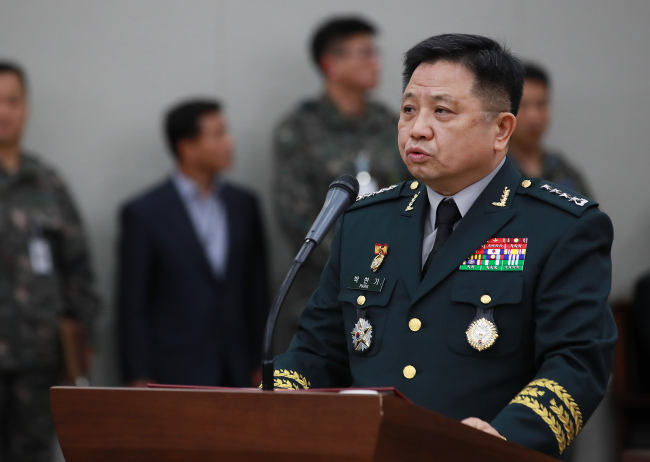South Korea's Joint Chiefs of Staff said Friday that it will "flexibly" handle the issue of the deployment of US strategic arms to Korea and its plan to establish a key defense system in line with progress in North Korea's denuclearization.
The remarks during a parliamentary audit spawned speculation that it could desist from requesting a US show of force with formidable assets, such as nuclear-capable bombers and aircraft carriers, and scale back its envisioned "three-axis" system.
The three-axis system, the centerpiece of efforts to counter the North's nuclear and missile threats, consists of Korea Massive Punishment and Retaliation, an operational plan to incapacitate the North Korean leadership in a major conflict; the Kill Chain pre-emptive strike platform; and the Korea Air and Missile Defense system.
 |
Gen. Park Han-ki, the chairman of the Joint Chiefs of Staff, speaks during a parliamentary audit at the JCS headquarters in Seoul on Oct. 12. (Yonhap) |
"In line with the changes in the security environment and with progress in North Korea's denuclearization, we will flexibly review the deployment of US strategic assets and the three-axis system," the JCS said.
The defense ministry said earlier that it would press ahead with the plan to develop the aggressive defense system despite growing speculation that ongoing efforts for inter-Korean detente could lead to a reduction or cancellation of the system.
A senior ministry official told Yonhap News Agency that a readjustment of the defense system remains possible if Pyongyang takes tangible denuclearization steps.
"A review of the readjustment remains open as long as the North is on course to denuclearization," the official said on condition of anonymity. "That is contingent on the North's denuclearization steps and whether it would affect our military's overall defense posture."
In its briefing, the JCS also touched on the plan to establish a system to counter persistent threats from the North's long-range artillery that put Seoul and its surrounding areas within striking range.
"We have been pursuing the deployment of a weapons system that fits our country's operational environment, so as to minimize the damage from a potential salvo of the North's long-range artillery attacks," the JCS said.
It added that in March, a decision has been made on the procurement of a new anti-artillery system. South Korea has currently been pushing to develop the Korea Tactical Surface to Surface Missile, or KTSSM, designed to destroy the North's artillery bases.
Regarding the argument in favor of purchasing the foreign "counter-rocket artillery mortar" system, the Iron Dome, the JCS appeared negative.
"After the review of the Iron Dome's efficacy, it was found that its defense capability is markedly lowered when the North launches a volley of long-range artillery attacks," it said.
Defense discourse here has focused largely on neutralizing the North's strategic weapons systems such as ballistic missiles and nuclear arms, while attention to more direct threats -- long-range artillery and multiple rocket launchers -- appears to be insufficient, observers said.
Pyongyang is known to possess a variety of rocket systems, including 170 mm caliber self-propelled howitzers and 240 mm multiple rocket launchers that can put Seoul and its vicinity within range.
In response to a lawmaker's call for the deployment of the Standard Missile-3, the JCS noted that the South Korean military decided last year on the need for a maritime anti-missile system mountable on an Aegis-equipped destroyer.
A senior Navy official told Yonhap that the decision has indicated a possibility for the deployment of the SM-3.
As the backbone of the US naval missile interception program, the SM-3 is designed to shoot down hostile missiles at altitudes of around 150 kilometers in the "mid-course" phase. If deployed, it could likely trigger friction with neighboring states such as China and Russia. (Yonhap)




![[Herald Interview] 'Trump will use tariffs as first line of defense for American manufacturing'](http://res.heraldm.com/phpwas/restmb_idxmake.php?idx=644&simg=/content/image/2024/11/26/20241126050017_0.jpg)


![[Health and care] Getting cancer young: Why cancer isn’t just an older person’s battle](http://res.heraldm.com/phpwas/restmb_idxmake.php?idx=644&simg=/content/image/2024/11/26/20241126050043_0.jpg)
